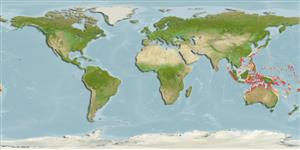Preferred temperature (Ref.
123201): 25.1 - 29.3, mean 28.5 °C (based on 1337 cells).
Phylogenetic diversity index (Ref.
82804): PD
50 = 0.5078 [Uniqueness, from 0.5 = low to 2.0 = high].
Bayesian length-weight: a=0.01023 (0.00477 - 0.02194), b=3.02 (2.84 - 3.20), in cm total length, based on LWR estimates for this (Sub)family-body shape (Ref.
93245).
Trophic level (Ref.
69278): 3.0 ±0.3 se; based on size and trophs of closest relatives
Resilience (Ref.
120179): Low, minimum population doubling time 4.5 - 14 years (Assumed Fec < 100).
Fishing Vulnerability (Ref.
59153): Low vulnerability (10 of 100).
Nutrients (Ref.
124155): Calcium = 449 [194, 1,616] mg/100g; Iron = 2.01 [0.81, 4.58] mg/100g; Protein = 18 [16, 20] %; Omega3 = 0.165 [0.049, 0.537] g/100g; Selenium = 32.3 [9.2, 96.3] μg/100g; VitaminA = 107 [20, 577] μg/100g; Zinc = 5.16 [2.67, 8.91] mg/100g (wet weight);
